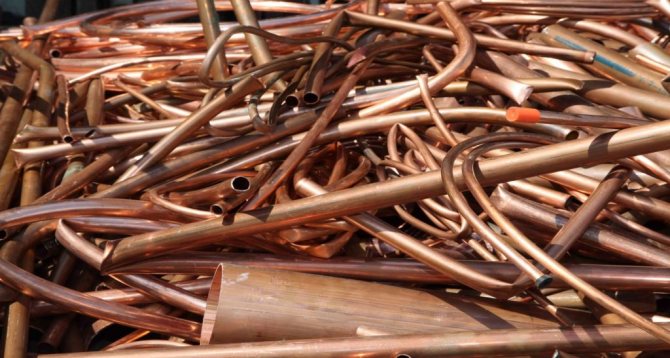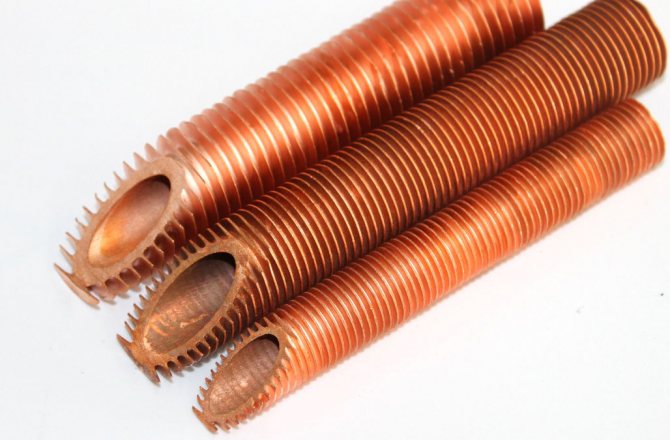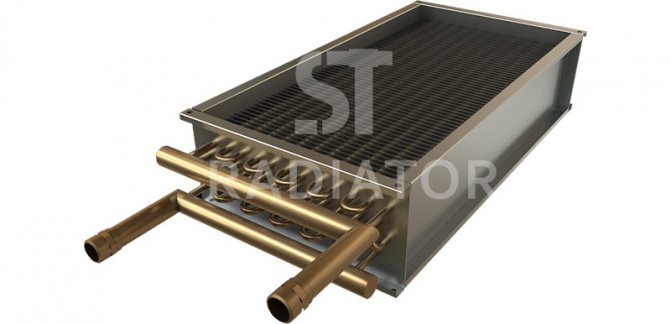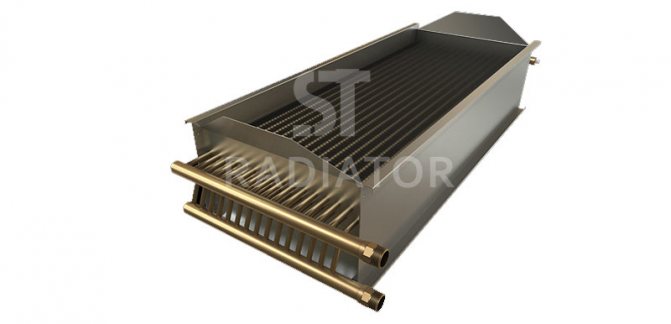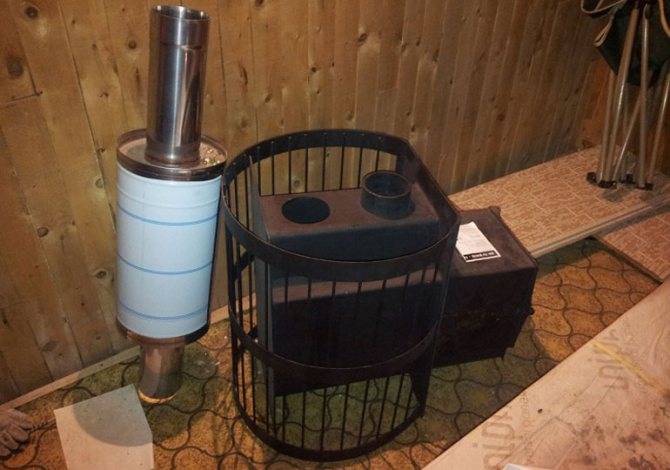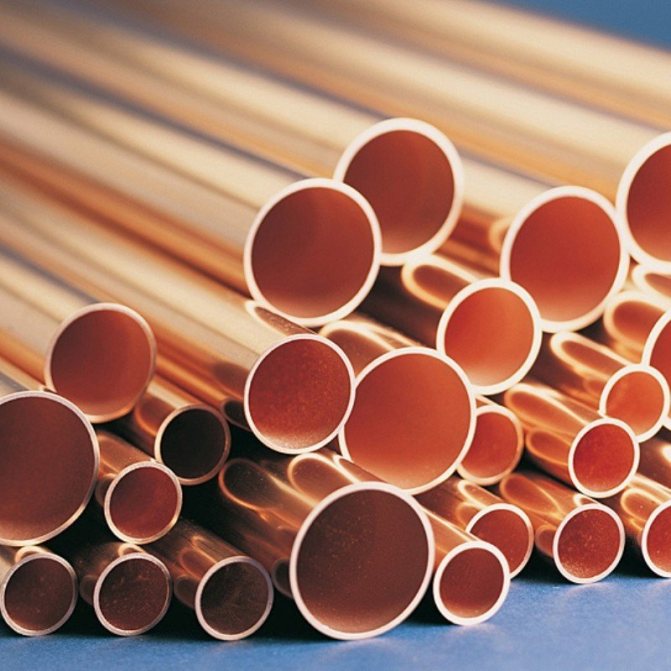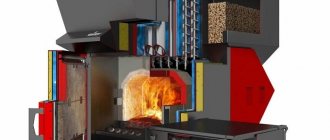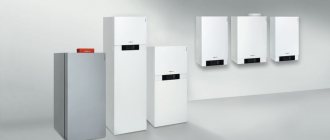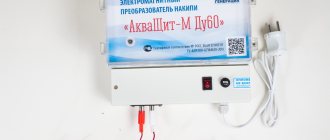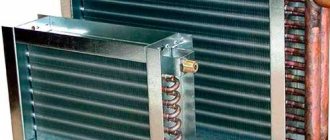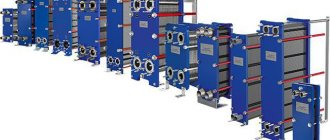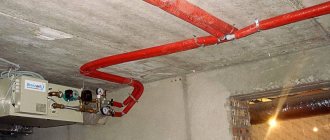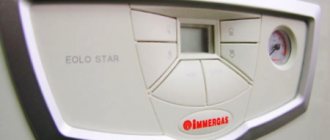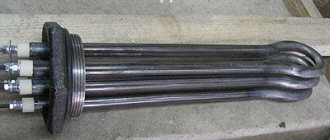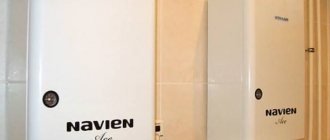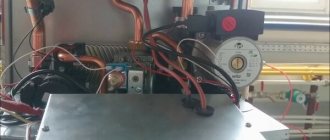Purpose, types of metal heat exchangers
The design and performance of heating devices depend on the purpose, principle of operation, and material of the heat exchanger. For example, it is impossible to create a compact cast iron product for a parapet or wall heater. Since carbon steel or cast iron has a significant density, and hence mass. Old cast iron boilers are a thing of the past. Small-sized heating structures with lightweight parts and a higher level of energy transfer are popular today. These include gas wall-hung boilers with a copper heat exchanger.
In the production of a thermodynamic structure, materials such as are used: • copper; • steel of different grades; • cast iron; • aluminum; • silumin.
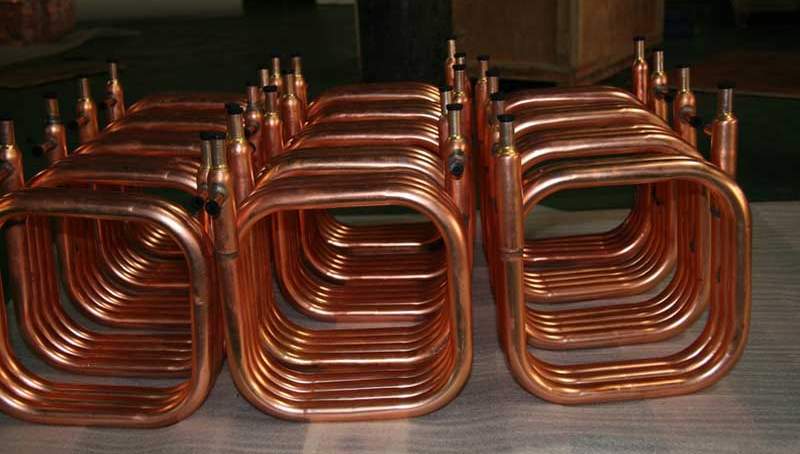
In modern domestic heating boilers, a heat exchange unit occupies most of its surface. The economic and environmental parameters of the boiler depend on the design and type of material.
Heat exchangers are classified depending on the purpose for such types as heating, cooling, condensing, evaporating. According to the principle of operation, the blocks are regenerative, recuperative and mixing. The first two types have the general name "thermal surface apparatus". One example of such units is radiators in cars. Their purpose is to participate in the operation of the engine cooling system. The heated water contacts the air through the walls of the copper-aluminum heat exchangers.
In mixing (contact) machines, two working streams (hot and cold) are mixed with each other. A similar process is observed in jet condensers, where the sprayed liquid uses the condensation energy. They are easier to manufacture and have a higher heat capacity. But the scope is limited.
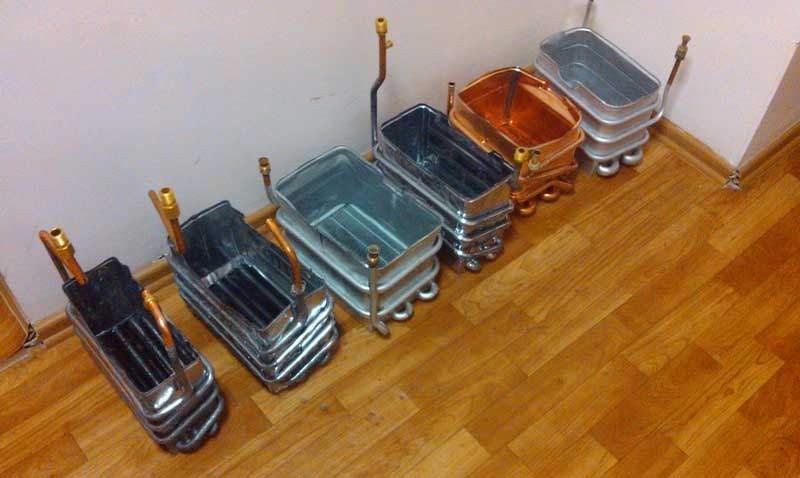

Heating devices made of steel and copper alloys
Since the mass production of household appliances is focused on the manufacture of heat exchangers from ferrous metal, gas boilers with a copper heat exchanger are considered a prestigious product. Copper has high heat transfer characteristics. Therefore, small boilers with a small amount of heat carrier can be used to heat a large house. As a result, the devices are very compact.
Important! Often, buyers are interested in which heat exchanger to choose - steel or copper. You need to proceed from the physical and chemical properties of ferrous and non-ferrous metals. The specific heat capacity of copper is lower than that of steel.
That is, to heat an equal amount of substance, copper needs to transfer less heat than steel. Accordingly, the inertia of the heating system, where there is a steel heat transfer unit, is greater. The boiler automation, working with a copper heat transfer block, reacts faster to an increase in the temperature of the coolant. As a result, this leads to fuel savings. An even greater reaction of the heating system to heating occurs when the pump is running. In addition, it provides improved circulation even with disturbed pipe slopes and prevents water from boiling.
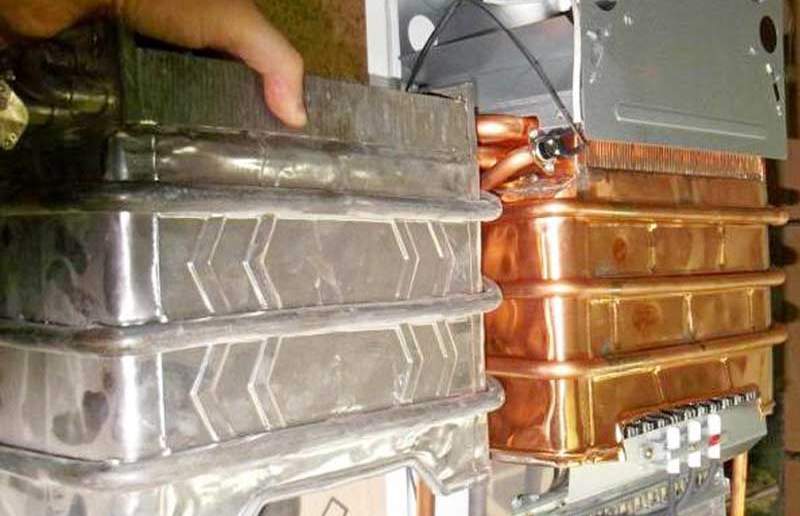

Comparing copper heat exchangers for boilers with steel, we can say that the latter are more plastic. This factor is important because there is a constant process of interaction with open fire. As a result, thermal stresses in the metal develop and cracks appear. Steel is more durable in this respect and can withstand a large number of cycles: heating - cooling.
The note! The disadvantages of steel, in addition to inertia, increased specific heat capacity, include: • susceptibility to corrosion; • increased volume of the air heater surface; • a large amount of coolant; • a significant mass of heating devices.
Which boiler is better, cast iron or steel (both gas and solid fuel).
Save the article for yourself or share it on your favorite social networks:
Which boiler is better, cast iron or steel (both gas and solid fuel).
I note right away that the overwhelming majority of manufacturing companies have the opportunity to carry out a full range of work related to testing the quality of manufactured heating equipment. Every sensor, every burner, every boiler ultimately goes through the entire list of planned tests. Moreover, we are not talking about pinpoint, but about 100% all-encompassing production control, which guarantees the high quality of the equipment produced. If the control is incomplete, then the risk of releasing a boiler device with defective parts increases tenfold.
German heating boilers
German equipment for home, sauna or office should be perceived as high quality by default. Defective products of manufacturers from Germany can only be if the device was hit, dropped, broken during transportation. At the same time, the German equipment is not designed for Russian frosts. For example, in 30-degree frosts, the device may simply not start, and the reason for this will be non-moving contacts. Only if “adapted to Russian conditions” is written on household or industrial products from Germany, you can be sure that no frosts are terrible for it. Otherwise, a German cast iron or steel gas boiler is guaranteed to be reliable and of high quality. This also applies to grates, long-burning devices, fire-tube, pyrolysis apparatuses, etc.
Popular manufacturers: kmch 5 combi, protherm, buderus, lemax, viadrus, danko, bober, bratsk, station wagon 6, vaillant, dacon, siberia, logano g211, ross, viadrus, genus.
Cast iron or steel?
In our country, you can find both cast iron and steel boiler equipment for solid fuels (wood, coal). Many experts argue that a good boiler must be made of cast iron. But there are also many masters who disagree with this opinion. Cast iron, of course, is an excellent material, but boiler equipment has been produced from it since the last century. Today there are no less worthy materials that can come to replace obsolete cast iron. One of these materials is steel. Initially, steel devices were sporadic and very expensive. Only with the development of serial production, which was launched after the advent of automatic welding technology, the price was reduced to acceptable levels. And today we can say that the steel boiler is on the same technical level with the cast iron one.
Advantages of cast iron devices
1. Boilers with a cast-iron heat exchanger are a sectional structure that can be easily assembled, disassembled, installed, moved to one place or another. In the event of an accident or breakdown, the sections can be quickly removed from the room. For comparison, steel devices are monolithic by default. A single block, welded in the factory floor, is unlikely to be frequently moved from place to place.
2. Durability. The service life of cast iron devices (even of a combined and universal type) reaches 50 years or more, subject to timely maintenance, necessary repairs or replacement of spare parts. Even now, old floor-standing boilers with Soviet-made doors serve regularly in the dachas of our citizens.
3. Anti-corrosion performance.Solid fuel cast iron boilers are reliably protected from rust formation. In the upper layers of the material, the so-called "dry rust" is formed, the crust from which does not allow corrosion to penetrate into the deeper layers. Even when it comes to wet corrosion, it will have a much weaker effect on cast iron devices than on steel boiler devices.
Condensate
However, protection against corrosion is a rather conditional technical characteristic. Most of the corrosion occurs in the firebox when the boiler walls are cooled to temperatures below the dew point (the temperature at which condensation forms on the boiler walls). For liquid fuel (diesel) devices, this temperature is 47-49 degrees. Gas appliances have a dew point of 54-55 degrees. And if the wall temperature, when interacting with the gases of the furnace, falls below the indicated values, condensation will form. It should be noted that the condensate consists not only of moisture, but also of sulfur oxide in fairly large volumes. When enriched with water, sulfur oxides form sulfuric acid, which is known to be very, very aggressive, especially when combined with other impurities. And if condensate manages to form in a cast-iron boiler, then an environment favorable for corrosion will give it all the opportunities to start destructive processes. Another thing is that the thickness of the walls allows the cast-iron device to withstand the pressure of rust much longer than the steel device. Well, if there is a need to completely protect the system from corrosion, you will have to spend money on competent professional design, which will take into account all the parameters of the room in which the boiler apparatus is located. The design should cover chimney pipes, radiator batteries, etc.
Benefits of steel devices
1. Steel solid fuel boilers are much lighter than cast iron apparatus. This is explained both by the weight of the material itself and by its thickness.
2. The cost of wood and coal steel devices is an order of magnitude less than cast iron, which can be explained by the previous point (although not only). Even under the condition that cast iron is cheaper than steel, the weight of a cast iron apparatus is several times greater than a steel one, which interrupts all the price difference.
3. A good steel boiler has a significantly higher efficiency than a cast iron boiler. This is explained by the numerous technological limitations of cast iron apparatuses.
Disadvantages of cast iron devices
Unfortunately, the art of correct handling of cast iron devices was lost after Soviet times, and today not every specialist can voice the rules for the correct operation of this type of devices. For example, if you fill a boiler with cold water during its operation, the material will burst immediately. And this is the best case! If the device does not burst, but explodes, trouble is inevitable. Steel in this regard is more stable, for which it is valued at the household level. The situation can be saved only by the correct strapping of cast-iron devices, in compliance with safety measures, but such a strapping turns out to be quite expensive. Another drawback is the impossibility of starting a homemade "return" in cast-iron double-circuit devices from a technical point of view. In this regard, the steel device is more loyal to the user.
conclusions
Which option to choose for your home? Having learned about all the advantages and disadvantages of steel and cast iron models, we can say with confidence that this is a matter of taste. Therefore, weigh the pros and cons before buying a boiler system with a water boiler from this or that material. Do not forget that if you choose single-circuit models, you will additionally have to spend money on installing hot water or steam-water boilers.
Comments, answers to questions
- Dim How to brew a cast iron boiler?
Reply
- Arseny Buy used steel boiler, inexpensive!
Reply
Gas water heater with copper heat exchanger
The gas column contains a heat exchanger, in which water is heated by a burner. Copper with a high heat transfer coefficient quickly transfers heat to the water, which is used for taking a bath. Copper products work the better, the fewer different impurities in the alloy. If they are present, the walls of the container heat up unevenly, which causes them to burn out quickly. Sometimes, in order to lower the price of a copper heat exchanger, the wall thickness and tube diameter are reduced. The weight of the empty apparatus is up to 3.5 kg.
The heat exchange unit is manufactured in the form of a tube. In the lower part, it has the shape of a snake with ribs. A metal sheet is installed around, and on top of it a spiral pipe. In addition to copper, galvanized and stainless steel is used. Which heat exchanger is better, copper or stainless steel, says the very fact of the cost of the device. Copper is 20 times more expensive than steel alloy. But it transfers heat better and is more economical in operation. Stainless steel is more durable.
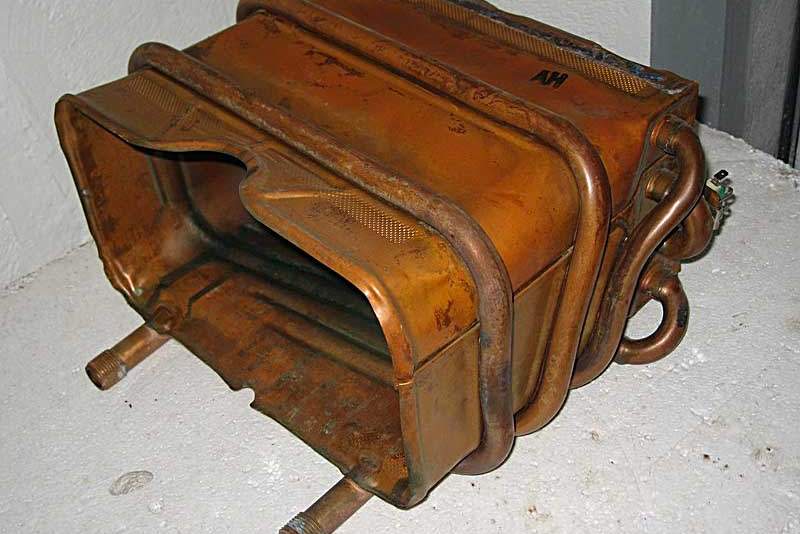

Important! Before buying a gas water heater with a copper heat exchanger, you should study its technical parameters. A good thing won't come cheap. Copper oxidizes strongly upon contact with water. This process is especially observed in the place where cold water is supplied. Condensation forms there. High humidity eats away at the tube wall and fistulas appear. They form quickly on thin walls. Quality goods will last the due time.
Freon channel coolers (FKO).
Freon duct coolers are manufactured in three-row or four-row design. The heat exchanger is made of aluminum plates and copper tubes with a diameter of 9.52 mm passing through them. Chess arrangement of tubes. Galvanized sheet steel casing. Refrigerant: freons R22, R407C, R410A.
Delivery of evaporators dry (filled with inert gas).
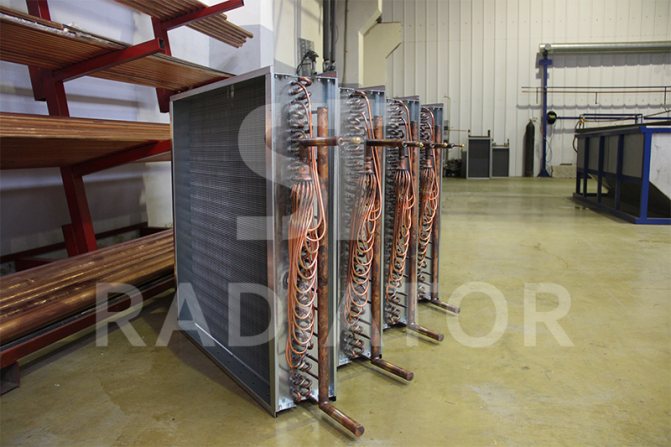

The channel group of heat exchangers working for cooling, by additional agreement, can be supplied in a housing with a drip tray and a tray.
View technical characteristics of freon duct coolers.
Repair of copper heat exchangers
During the operation of evaporators, different types of damage appear: • breaks in pipes at the point of water supply and its outlet; • violation of integrity as a result of water hammer; • dents, fistulas; • violation of the tightness of threaded connections.
Before starting the repair, a search is performed for microcracks that are not visually noticeable. Hidden defects can only be detected by crimping. The fistulas are removed by brazing the copper heat exchanger using high temperature brazing alloys.
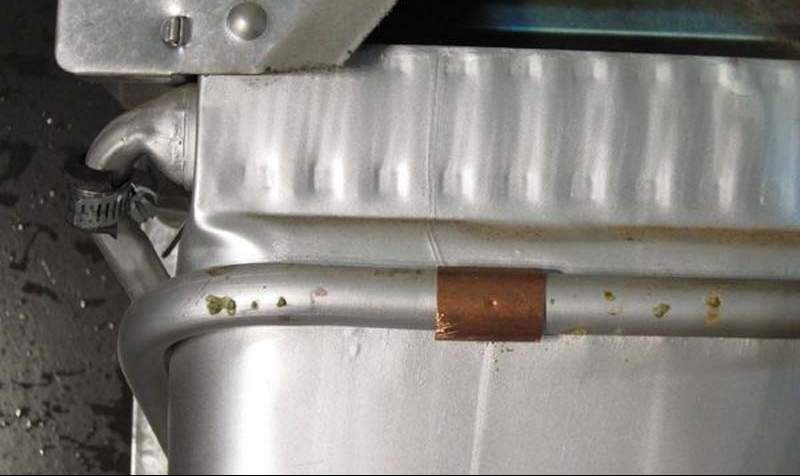

For work you need a soldering iron, flux and solder. First, a flux is applied, which cleans the surface of oxidized particles. It also helps to distribute the solder evenly. A paste that contains copper is used as a flux. If it is not there, then you can take rosin and even an aspirin tablet.
The note! When welding a copper heat exchanger, it is necessary that the solder melts from the tube, and not from contact with the soldering iron.
The layer of solder in the place of damage builds up gradually until its thickness reaches 1-2 mm. The burner flame must be medium, otherwise the evaporator can be damaged further. After the end of the soldering, you need to remove the remaining flux. Because the acid it contains corrodes copper.

